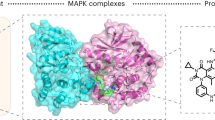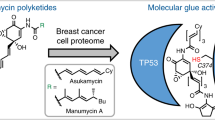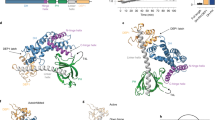Abstract
HAMLET (Human Alpha-lactalbumin Made LEthal to Tumor cells) kills tumor cells broadly suggesting that conserved survival pathways are perturbed. We now identify nucleotide-binding proteins as HAMLET binding partners, accounting for about 35% of all HAMLET targets in a protein microarray comprising 8000 human proteins. Target kinases were present in all branches of the Kinome tree, including 26 tyrosine kinases, 10 tyrosine kinase-like kinases, 13 homologs of yeast sterile kinases, 4 casein kinase 1 kinases, 15 containing PKA, PKG, PKC family kinases, 15 calcium/calmodulin-dependent protein kinase kinases and 13 kinases from CDK, MAPK, GSK3, CLK families. HAMLET acted as a broad kinase inhibitor in vitro, as defined in a screen of 347 wild-type, 93 mutant, 19 atypical and 17 lipid kinases. Inhibition of phosphorylation was also detected in extracts from HAMLET-treated lung carcinoma cells. In addition, HAMLET recognized 24 Ras family proteins and bound to Ras, RasL11B and Rap1B on the cytoplasmic face of the plasma membrane. Direct cellular interactions between HAMLET and activated Ras family members including Braf were confirmed by co-immunoprecipitation. As a consequence, oncogenic Ras and Braf activity was inhibited and HAMLET and Braf inhibitors synergistically increased tumor cell death in response to HAMLET. Unlike most small molecule kinase inhibitors, HAMLET showed selectivity for tumor cells in vitro and in vivo. The results identify nucleotide-binding proteins as HAMLET targets and suggest that dysregulation of the ATPase/kinase/GTPase machinery contributes to cell death, following the initial, selective recognition of HAMLET by tumor cells. The findings thus provide a molecular basis for the conserved tumoricidal effect of HAMLET, through dysregulation of kinases and oncogenic GTPases, to which tumor cells are addicted.
This is a preview of subscription content, access via your institution
Access options
Subscribe to this journal
Receive 50 print issues and online access
$259.00 per year
only $5.18 per issue
Buy this article
- Purchase on Springer Link
- Instant access to full article PDF
Prices may be subject to local taxes which are calculated during checkout






Similar content being viewed by others
References
Manning BD, Cantley LC . Hitting the target: emerging technologies in the search for kinase substrates. Sci Signal 2002; 162: pe49–pe49.
Chene P . ATPases as drug targets: learning from their structure. Nat Rev Drug Discov 2002; 1: 665–673.
Manning G, Whyte DB, Martinez R, Hunter T, Sudarsanam S . The protein kinase complement of the human genome. Science 2002; 298: 1912–1934.
Takai Y, Sasaki T, Matozaki T . Small GTP-binding proteins. Phys Rev 2001; 81: 153–208.
Baselga J . Targeting tyrosine kinases in cancer: the second wave. Science 2006; 312: 1175–1178.
Hu Y, Swerdlow S, Duffy TM, Weinmann R, Lee FY, Li S . Targeting multiple kinase pathways in leukemic progenitors and stem cells is essential for improved treatment of Ph+ leukemia in mice. Proc Natl Acad Sci USA 2006; 103: 16870–16875.
Hakansson A, Zhivotovsky B, Orrenius S, Sabharwal H, Svanborg C . Apoptosis induced by a human milk protein. Proc Natl Acad Sci USA 1995; 92: 8064–8068.
Svensson M, Hakansson A, Mossberg AK, Linse S, Svanborg C . Conversion of alpha-lactalbumin to a protein inducing apoptosis. Proc Natl Acad Sci USA 2000; 97: 4221–4226.
Fischer W, Gustafsson L, Mossberg AK, Gronli J, Mork S, Bjerkvig R et al. Human alpha-lactalbumin made lethal to tumor cells (HAMLET) kills human glioblastoma cells in brain xenografts by an apoptosis-like mechanism and prolongs survival. Cancer Res 2004; 64: 2105–2112.
Mossberg AK, Hou Y, Svensson M, Holmqvist B, Svanborg C . HAMLET treatment delays bladder cancer development. J Urol 2010; 183: 1590–1597.
Puthia M, Storm P, Nadeem A, Hsiung S, Svanborg C . Prevention and treatment of colon cancer by peroral administration of HAMLET (human alpha-lactalbumin made lethal to tumour cells). Gut 2014; 63: 131–142.
Gustafsson L, Leijonhufvud I, Aronsson A, Mossberg AK, Svanborg C . Treatment of skin papillomas with topical alpha-lactalbumin-oleic acid. N Engl J Med 2004; 350: 2663–2672.
Mossberg AK, Wullt B, Gustafsson L, Mansson W, Ljunggren E, Svanborg C . Bladder cancers respond to intravesical instillation of HAMLET (human alpha-lactalbumin made lethal to tumor cells). Int J Cancer 2007; 121: 1352–1359.
Storm P, Klausen TK, Trulsson M, Ho CSJ, Dosnon M, Westergren T et al. A unifying mechanism for cancer cell death through ion channel activation by HAMLET. PLoS One 2013; 8: e58578.
Duringer C, Hamiche A, Gustafsson L, Kimura H, Svanborg C . HAMLET interacts with histones and chromatin in tumor cell nuclei. J Biol Chem 2003; 278: 42131–42135.
Gustafsson L, Aits S, Onnerfjord P, Trulsson M, Storm P, Svanborg C . Changes in proteasome structure and function caused by HAMLET in tumor cells. PLoS One 2009; 4: e5229.
Storm P, Aits S, Puthia MK, Urbano A, Northen T, Powers S et al. Conserved features of cancer cells define their sensitivity to HAMLET-induced death; c-Myc and glycolysis. Oncogene 2011; 30: 4765–4779.
Trulsson M, Yu H, Gisselsson L, Chao Y, Urbano A, Aits S et al. HAMLET binding to alpha-actinin facilitates tumor cell detachment. PLoS One 2011; 6: e17179.
MacBeath G, Schreiber SL . Printing proteins as microarrays for high-throughput function determination. Science 2000; 289: 1760–1763.
Anastassiadis T, Deacon SW, Devarajan K, Ma H, Peterson JR . Comprehensive assay of kinase catalytic activity reveals features of kinase inhibitor selectivity. Nat Biotechnol 2011; 29: 1039–1045.
Newman RH, Hu J, Rho HS, Xie Z, Woodard C, Neiswinger J et al. Construction of human activity-based phosphorylation networks. Mol Syst Biol 2013; 9: 655.
Hancock JF . Ras proteins: different signals from different locations. Nat Rev Mol Cell Biol 2003; 4: 373–384.
Moser AR, Pitot HC, Dove WF . A dominant mutation that predisposes to multiple intestinal neoplasia in the mouse. Science 1990; 247: 322–324.
Ho J, Sielaff H, Nadeem A, Svanborg C, Gruber G . The molecular motor F-ATP synthase is targeted by the tumoricidal protein HAMLET. J Mol Biol 2015; 427: 1866–1874.
Garuti L, Roberti M, Bottegoni G . Non-ATP competitive protein kinase inhibitors. Curr Med Chem 2010; 17: 2804–2821.
Hojjat-Farsangi M . Small-molecule inhibitors of the receptor tyrosine kinases: promising tools for targeted cancer therapies. Int J Mol Sci 2014; 15: 13768–13801.
Druker BJ . Translation of the Philadelphia chromosome into therapy for CML. Blood 2008; 112: 4808–4817.
Flaherty KT, Puzanov I, Kim KB, Ribas A, McArthur GA, Sosman JA et al. Inhibition of mutated, activated BRAF in metastatic melanoma. N Engl J Med 2010; 363: 809–819.
Nakano H, Omura S . Chemical biology of natural indolocarbazole products: 30 years since the discovery of staurosporine. J Antibiot 2009; 62: 17–26.
Tamaoki T, Nakano H . Potent and specific inhibitors of protein kinase C of microbial origin. Biotech 1990; 8: 732–735.
Meggio F, Donella Deana A, Ruzzene M, Brunati AM, Cesaro L, Guerra B et al. Different susceptibility of protein kinases to staurosporine inhibition. Kinetic studies and molecular bases for the resistance of protein kinase CK2. Eur J Biochem 1995; 234: 317–322.
Chandarlapaty S, Sawai A, Scaltriti M, Rodrik-Outmezguine V, Grbovic-Huezo O, Serra V et al. AKT inhibition relieves feedback suppression of receptor tyrosine kinase expression and activity. Cancer Cell 2011; 19: 58–71.
Rodrik-Outmezguine VS, Chandarlapaty S, Pagano NC, Poulikakos PI, Scaltriti M, Moskatel E et al. mTOR kinase inhibition causes feedback-dependent biphasic regulation of AKT signaling. Cancer Discov 2011; 1: 248–259.
Duncan James S, Whittle Martin C, Nakamura K, Abell Amy N, Midland Alicia A, Zawistowski Jon S et al. Dynamic reprogramming of the kinome in response to targeted MEK inhibition in triple-negative breast cancer. Cell 2012; 149: 307–321.
Egorov VV, Garmaj YP, Solovyov KV, Grudinina NA, Aleinikova TD, Sirotkin AK et al. Amyloidogenic peptide homologous to beta-domain region of alpha-lactalbumin. Biochem Biophys 2007; 414: 152–154.
Garrett JT, Olivares MG, Rinehart C, Granja-Ingram ND, Sanchez V, Chakrabarty A et al. Transcriptional and posttranslational up-regulation of HER3 (ErbB3) compensates for inhibition of the HER2 tyrosine kinase. Proc Natl Acad Sci USA 2011; 108: 5021–5026.
Weinstein IB, Joe A . Oncogene addiction. Cancer Res 2008; 68: 3077–3080.
Harvey JJ . An unidentified virus which causes the rapid production of tumours in mice. Nature 1964; 204: 1104–1105.
Kirsten WH, Schauf V, McCoy J . Properties of a murine sarcoma virus. Bibl Haematol 1970; 36: 246–249.
Stolle K, Schnoor M, Fuellen G, Spitzer M, Cullen P, Lorkowski S . Cloning, genomic organization, and tissue-specific expression of the RASL11B gene. Biochim Biophys Acta 2007; 1769: 514–524.
Zerial M, McBride H . Rab proteins as membrane organizers. Nat Rev Mol Cell Biol 2001; 2: 107–117.
Yan J, Li F, Ingram DA, Quilliam LA . Rap1a is a key regulator of fibroblast growth factor 2-induced angiogenesis and together with Rap1b controls human endothelial cell functions. Mol Cell Biol 2008; 28: 5803–5810.
Spang A, Shiba Y, Randazzo PA . Arf GAPs: gatekeepers of vesicle generation. FEBS Lett 2010; 584: 2646–2651.
Tee AR, Blenis J, Proud CG . Analysis of mTOR signaling by the small G-proteins, Rheb and RhebL1. FEBS Lett 2005; 579: 4763–4768.
Rebhun JF, Castro AF, Quilliam LA . Identification of guanine nucleotide exchange factors (GEFs) for the Rap1 GTPase. Regulation of MR-GEF by M-Ras-GTP interaction. J Biol Chem 2000; 275: 34901–34908.
Mor A, Philips MR . Compartmentalized Ras/MAPK signaling. Annu Rev Immunol 2006; 24: 771–800.
Sekiguchi T, Todaka Y, Wang Y, Hirose E, Nakashima N, Nishimoto T . A novel human nucleolar protein, Nop132, binds to the G proteins, RRAG A/C/D. J Biol Chem 2004; 279: 8343–8350.
Satoh J, Nanri Y, Yamamura T . Rapid identification of 14-3-3-binding proteins by protein microarray analysis. J Neurosci Meth 2006; 152: 278–288.
Pettersen EF, Goddard TD, Huang CC, Couch GS, Greenblatt DM, Meng EC et al. UCSF Chimera—a visualization system for exploratory research and analysis. J Comp Chem 2004; 25: 1605–1612.
Acknowledgements
This study was supported by the Sharon D Lund foundation grant, the Swedish Cancer Society, the Medical Faculty (Lund University), the Söderberg Foundation, the Segerfalk Foundation, the Maggie Stephens Foundation, the Gunnar Nilsson Cancer Foundation, the Inga-Britt and Arne Lundberg Foundation, the HJ Forssman Foundation for Medical Research and the Royal Physiographic Society. We thank Petter Storm for conducting the Biacore and Braf activity experiments.
Author information
Authors and Affiliations
Corresponding author
Ethics declarations
Competing interests
The authors declare no competing financial interests and the studies have not been funded by commercial sources. CS is a shareholder in HAMLET Pharma, a company holding patent rights to HAMLET.
Additional information
Supplementary Information accompanies this paper on the Oncogene website
Supplementary information
Rights and permissions
About this article
Cite this article
Ho, J., Nadeem, A., Rydström, A. et al. Targeting of nucleotide-binding proteins by HAMLET—a conserved tumor cell death mechanism. Oncogene 35, 897–907 (2016). https://doi.org/10.1038/onc.2015.144
Received:
Revised:
Accepted:
Published:
Issue Date:
DOI: https://doi.org/10.1038/onc.2015.144
This article is cited by
-
HAMLET effect on cell death and mitochondrial respiration in colorectal cancer cell lines with KRAS/BRAF mutations
Journal of Cancer Research and Clinical Oncology (2023)
-
Bladder cancer therapy using a conformationally fluid tumoricidal peptide complex
Nature Communications (2021)
-
Gold/alpha-lactalbumin nanoprobes for the imaging and treatment of breast cancer
Nature Biomedical Engineering (2020)
-
The Use of Human, Bovine, and Camel Milk Albumins in Anticancer Complexes with Oleic Acid
The Protein Journal (2018)
-
PhosphoPredict: A bioinformatics tool for prediction of human kinase-specific phosphorylation substrates and sites by integrating heterogeneous feature selection
Scientific Reports (2017)



